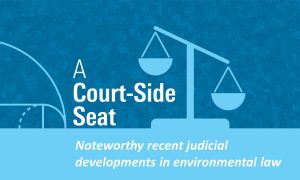There are no shortage of bankruptcy considerations that must be understood by an incoming lender who acquires a distressed commercial real estate loan and whose borrower shortly thereafter files for bankruptcy protection. For the purposes of this article, we imagine a hypothetical distressed debt buyer who has acquired the loan with the goal of eventually obtaining the underlying property and who may be distressed (pun intended!) by the bankruptcy filing. While often considered an impediment to acquisition efforts, we believe that bankruptcy presents significant benefits and opportunities for the strategic loan-to-own investor.
The G2G Year-End Roundup (2022)
Our year-end roundup highlights the top-read Gravel2Gavel posts from 2022. Our authors addressed the legal implications for a variety of hot topics and market disruptions, providing deep industry insights that spanned Metaverse real estate investments, economic sanctions in Russia, and cybersecurity for smart buildings.
Real Estate & Construction News Round-Up (12/07/22) – Home Sales, EV Charging Infrastructure, and Office Occupancy
This week’s round-up explores decreasing home sales, electric vehicle charging stations, office occupancy levels, and more.
Real Estate & Construction News Round-Up (11/30/22) – Proptech Trends, Green Construction, and Sustainable Buildings
This week’s round-up explores 4 key trends expected to impact proptech in 2023, global investment in green construction technologies, sustainable buildings and their perceived value for tenants in Europe, and more.
UCC Foreclosure Basics: Acquisition of Distressed Real Estate Mezzanine Debt
We recently provided an outline of items to diligence when purchasing a mortgage loan in distress—and separately also discussed issues to diligence when purchasing a mezzanine loan in distress. This post (the third in this series) outlines Uniform Commercial Code (UCC) foreclosures in general terms and describes key considerations for mezzanine lenders (and the purchasers of distressed mezzanine loans) contemplating or planning a UCC foreclosure.
Real Estate & Construction News Round-Up (11/16/22) – Backlog Shifts, Green Battery Storage, and Russia-Ukraine Updates
This week’s round-up explores backlog shifts in the nonresidential construction sector, updates from the ongoing war between Russia and Ukraine, lithium-ion battery storage issues in New York City, and more.
Acquiring Distressed Real Estate Mezzanine Debt: A Diligence Checklist
We recently discussed the importance of diligence when acquiring distressed commercial mortgage loans, providing a diligence checklist for the process. Given that any foreclosing mezzanine lender may step “into ownership” if it forecloses upon its mezzanine loan, perhaps even greater care should be exercised when considering the purchase of a distressed real estate mezzanine loan. As with a mortgage loan, diligence is key!
Real Estate & Construction News Round-Up (11/09/22) – Fractional NFTs, Infrastructure Lobbying, and Experimental Retail
This week’s round-up dives into NFT fractionalization and its potential benefit to increase accessibility in real estate investing, lobbying efforts surrounding Infrastructure Investment and Jobs Act (IIJA) funding, experimental retail spaces, and more.
A Court-Side Seat: Recent Legal Developments at Supreme and Federal Appeals Courts
This is a review of initial Supreme Court and Federal Appeals Courts oral arguments and other matters in October 2022.






